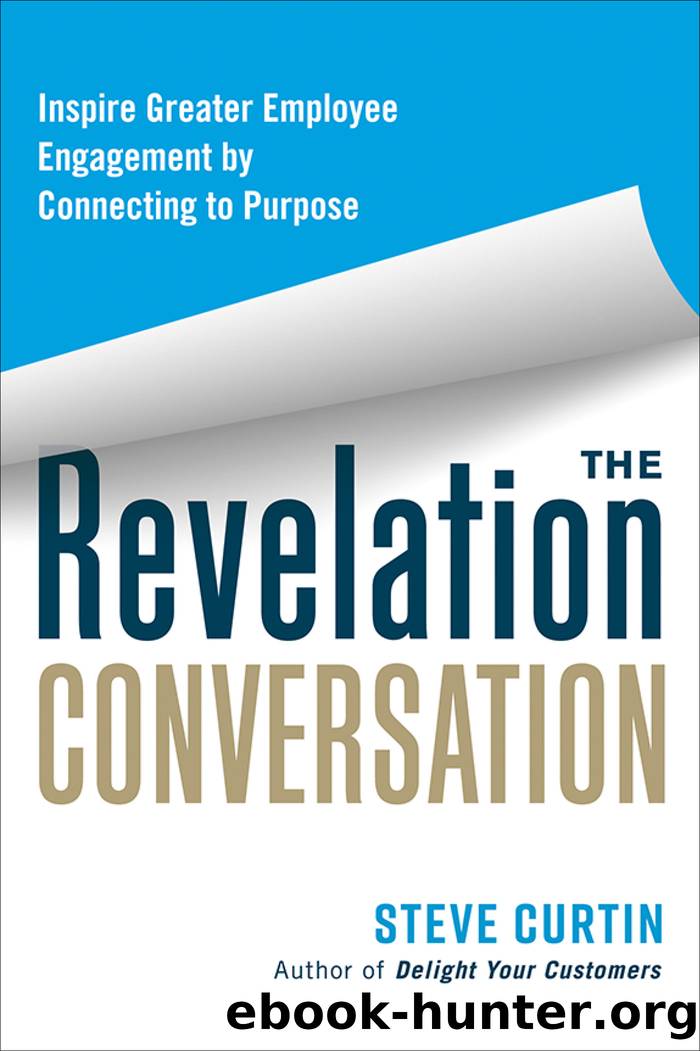The Revelation Conversation by Steve Curtin

Author:Steve Curtin
Language: eng
Format: epub
Publisher: Berrett-Koehler Publishers
Exercise
Schedule your first Revelation Conversation with a specific employee with the goal of initiating the conversation with each member of your staff in the coming days or weeks.
Below, write the name (or initials) of the employee, place, date, and time you will hold the conversation.
Name: ____________________________________ Date: ____________
Place: ____________________________________ Time: ____________
Using the framework below, prepare for the conversation, paying particular attention to being
⢠prepared to accept personal responsibility for the employeeâs probable incomplete view of their job role
⢠grounded in the organizationâs purpose, culture, corporate ideals, and performance standards, and how these connect to the employeeâs job purpose
⢠ready with examples of purposeful job-specific actions and behaviors (e.g., being observant, taking initiative, displaying a sense of urgency, sharing unique knowledge, using appropriate humor)
Lead-off question. Begin the conversation by asking the employee this question:
1. âWould you describe for me, from your perspective, your job roleâwhat your job entails?â
They will likely provide a list dominated by job functions.
Validate the response, accept personal responsibility for omissions, and reveal the totality of the job role. It is critical that you do not appear to judge their response and, assuming it is devoid of any reference to purposeful actions or behaviors, imply that the employee should be aware of a dimension of their job role that was omitted. Instead, validate the job functions listed (theyâre essential) and accept responsibility for the employeeâs incomplete view of their job role that led to the omission of actions or behaviors that reflect job purpose. You might say:
2. âThatâs an impressive list of job functions, the duties and tasks related to your job role. All of those things are important and necessaryâeven critical to our success. Though, if thatâs how you would describe the totality of your job role, then I have explained your job to you incompletely. Job functions make up only one aspect of your job role. The other dimension of your job role is job essence.â
They will likely ask, âWhat is job essence?â
Clarify job essence. Then you will clarify by saying:
3. âJob essence is how you reflect, through actions and behaviors, the purpose of your job role; your single highest priority at work.â
They will likely ask, âWhatâs that?â
Clarify job purpose. And then you will say:
4. âYour single highest priority at work is to __________________________________________________________.â (This may match the job purpose that you articulated for your own job role in chapter 3.)
Then they might ask, âHow do I do that?â
The payoff. As mentioned, the conversation that follows, besides serving customers directly, might just be the best use of your time at work. This is a great opportunity to
⢠reinforce performance standards
⢠inspire the employee to realize their potential at work
⢠raise expectations and challenge the employee professionally
⢠demonstrate support for the employeeâs success in their job role
⢠reflect openness and honesty in communication
⢠show personal interest in the employee
⢠build the relationship
⢠convey that you are a purpose-driven leader
Download
This site does not store any files on its server. We only index and link to content provided by other sites. Please contact the content providers to delete copyright contents if any and email us, we'll remove relevant links or contents immediately.
| Ethics | Etiquette |
| Fashion & Image | Health & Stress |
| Motivation & Self-Improvement | Work Life Balance |
| Workplace Culture |
Tools of Titans by Timothy Ferriss(8211)
Change Your Questions, Change Your Life by Marilee Adams(7633)
Deep Work by Cal Newport(6873)
Man-made Catastrophes and Risk Information Concealment by Dmitry Chernov & Didier Sornette(5921)
Playing to Win_ How Strategy Really Works by A.G. Lafley & Roger L. Martin(5911)
Digital Minimalism by Cal Newport;(5661)
Big Magic: Creative Living Beyond Fear by Elizabeth Gilbert(5609)
The Slight Edge by Jeff Olson(5346)
Ego Is the Enemy by Ryan Holiday(5292)
The Motivation Myth by Jeff Haden(5154)
Stone's Rules by Roger Stone(5026)
The Laws of Human Nature by Robert Greene(4995)
Tuesdays with Morrie by Mitch Albom(4683)
Eat That Frog! by Brian Tracy(4430)
Rising Strong by Brene Brown(4377)
Skin in the Game by Nassim Nicholas Taleb(4161)
Bullshit Jobs by David Graeber(4093)
The Money Culture by Michael Lewis(4073)
Skin in the Game: Hidden Asymmetries in Daily Life by Nassim Nicholas Taleb(3929)
